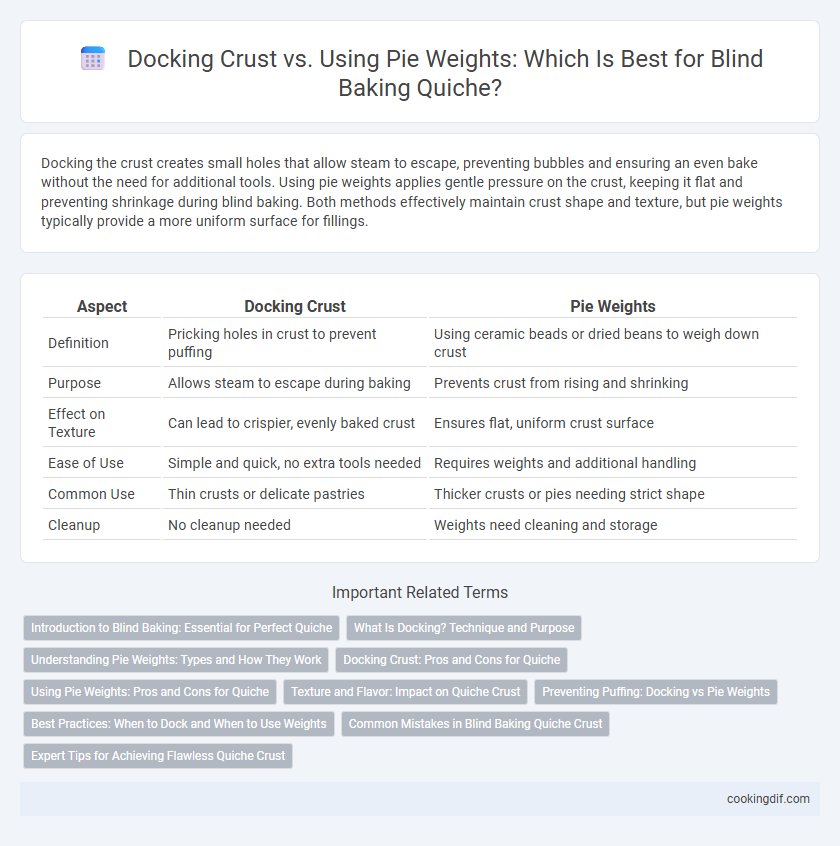Docking the crust creates small holes that allow steam to escape, preventing bubbles and ensuring an even bake without the need for additional tools. Using pie weights applies gentle pressure on the crust, keeping it flat and preventing shrinkage during blind baking. Both methods effectively maintain crust shape and texture, but pie weights typically provide a more uniform surface for fillings.
Table of Comparison
| Aspect | Docking Crust | Pie Weights |
|---|---|---|
| Definition | Pricking holes in crust to prevent puffing | Using ceramic beads or dried beans to weigh down crust |
| Purpose | Allows steam to escape during baking | Prevents crust from rising and shrinking |
| Effect on Texture | Can lead to crispier, evenly baked crust | Ensures flat, uniform crust surface |
| Ease of Use | Simple and quick, no extra tools needed | Requires weights and additional handling |
| Common Use | Thin crusts or delicate pastries | Thicker crusts or pies needing strict shape |
| Cleanup | No cleanup needed | Weights need cleaning and storage |
Introduction to Blind Baking: Essential for Perfect Quiche
Blind baking quiche crust involves pre-baking the dough to prevent sogginess and ensure a crisp, flaky texture. Docking the crust by pricking it with a fork allows steam to escape, reducing bubbles but may not prevent shrinking, while using pie weights exerts even pressure to maintain the crust's shape during baking. Choosing between docking and pie weights depends on the desired crust quality, with pie weights generally providing a more uniform, professional result for perfect quiche.
What Is Docking? Technique and Purpose
Docking is the technique of pricking holes in pie or quiche crust with a fork before baking to allow steam to escape, preventing the dough from puffing up and creating an uneven surface. This method contrasts with using pie weights, which physically press down the crust during blind baking to maintain its shape and prevent shrinking. Docking ensures a crisp, flat crust ideal for quiches, while pie weights provide additional support when the crust needs to hold a heavy filling without collapsing.
Understanding Pie Weights: Types and How They Work
Pie weights, typically made from ceramic beads, steel, or dried beans, help evenly distribute heat and prevent the crust from puffing or shrinking during blind baking. Ceramic and steel weights conduct heat efficiently, ensuring a crisp bottom, while dried beans are a budget-friendly option, though they may not heat as evenly. Understanding the types and functions of pie weights allows bakers to achieve a perfectly blind-baked quiche crust without docking, which involves piercing the dough to release steam.
Docking Crust: Pros and Cons for Quiche
Docking the crust for quiche involves piercing the dough with a fork to allow steam to escape during blind baking, which helps prevent bubbles and keeps the crust flat and even. This method is simple and requires no extra tools, preserving the crust's tender texture without the risk of dents or unevenness caused by pie weights. However, docking can sometimes lead to a less crisp bottom crust if moisture seeps through the holes, making it less ideal for custard-heavy quiches.
Using Pie Weights: Pros and Cons for Quiche
Using pie weights for blind baking quiche crust ensures even heat distribution, preventing puffing and shrinkage while maintaining a crisp texture essential for holding wet fillings. Pie weights are reusable and help achieve a uniformly baked crust, but they require careful handling to avoid puncturing the dough or leaving marks that may affect the final presentation. This method is preferred for delicate quiche preparations needing structural integrity without excessive browning or sogginess.
Texture and Flavor: Impact on Quiche Crust
Docking the crust creates small holes that allow steam to escape, resulting in a crispier texture but a slightly drier flavor profile in quiche crusts. Using pie weights prevents the crust from puffing and maintains a tender, flaky texture with a richer buttery flavor due to minimal moisture loss. Choosing between docking and pie weights directly influences the crust's structural integrity and enhances different aspects of the quiche's overall taste experience.
Preventing Puffing: Docking vs Pie Weights
Docking the quiche crust with a fork creates small holes that allow steam to escape, effectively preventing puffing during blind baking. Using pie weights applies even pressure on the dough, ensuring it stays flat and maintains its shape without rising. Both methods are essential for a perfectly baked quiche crust, offering distinct advantages depending on the desired texture and appearance.
Best Practices: When to Dock and When to Use Weights
Docking the quiche crust with a fork is ideal for recipes requiring a crisp, evenly baked base without added weight, preventing bubbles during blind baking. Using pie weights is best when a flawless, smooth surface is needed for delicate fillings that might otherwise cause the crust to puff or shrink. Combining both methods depends on the filling: dock for sturdier, dry quiche fillings; use weights for custardy or wet fillings to maintain structure and texture integrity.
Common Mistakes in Blind Baking Quiche Crust
Using pie weights to prevent the quiche crust from puffing is common, but placing parchment paper incorrectly can cause uneven baking and soggy spots. Docking the crust by pricking holes evenly helps steam escape, reducing bubbles, yet over-docking risks creating holes that fill with custard, leading to leakage. One frequent mistake is neglecting to chill the dough thoroughly before blind baking, which results in shrinking or misshaped crust edges in quiche preparation.
Expert Tips for Achieving Flawless Quiche Crust
Using docking crust techniques creates tiny holes that allow steam to escape, preventing bubbles and ensuring an evenly baked quiche crust. Pie weights offer stability by maintaining shape during blind baking, minimizing shrinkage and crisping the crust edge perfectly. Combining docking with high-quality ceramic or stainless steel pie weights yields the best results for a flawless, tender quiche base.
Docking crust vs using pie weights for blind baking Infographic

 cookingdif.com
cookingdif.com